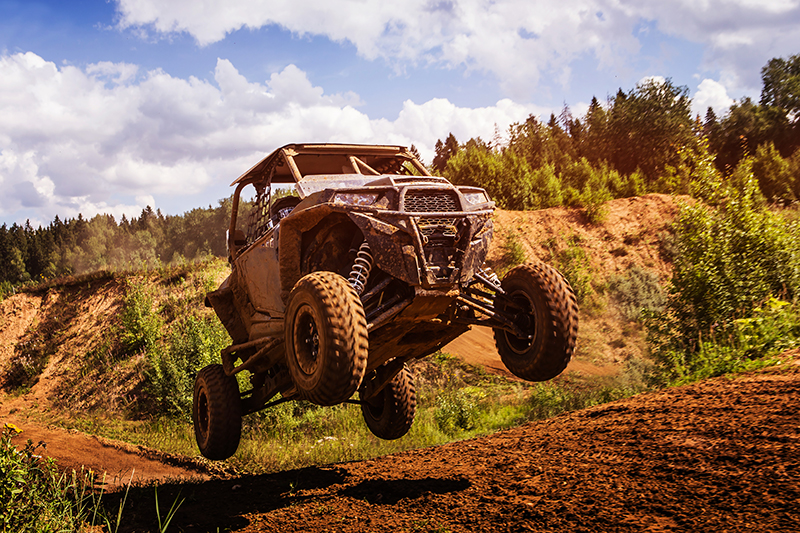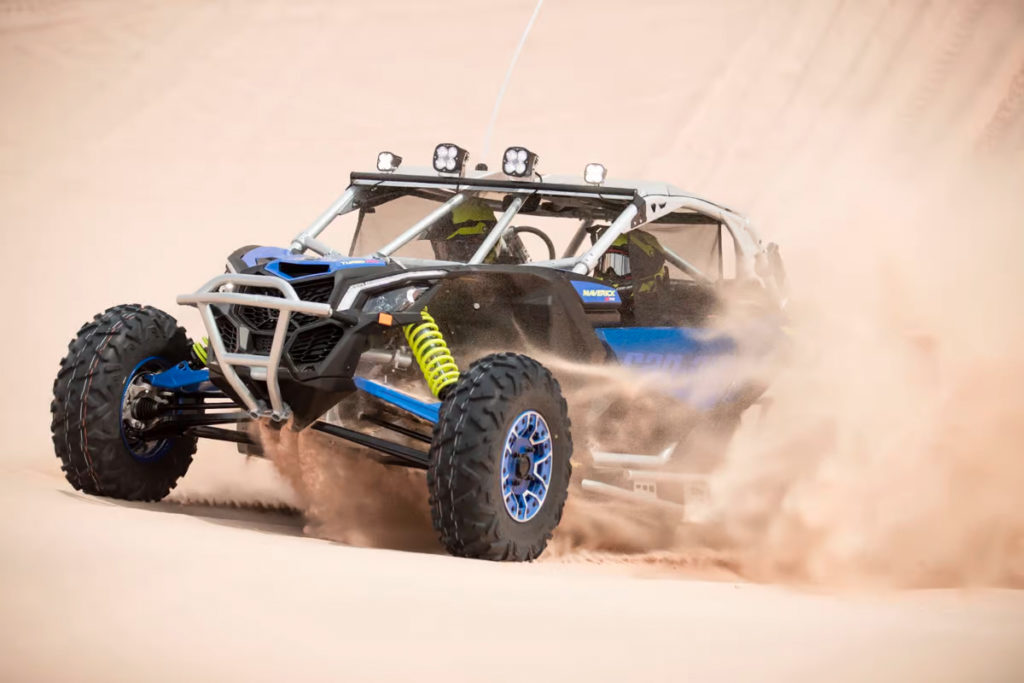
What does UTV Stand for?
UTV stands for Utility Terrain Vehicle. This type of vehicle, also known as a side-by-side, is designed for both recreational and utility use. UTVs are larger than ATVs (All-Terrain Vehicles) and are designed to carry more passengers and cargo
When it comes to off-road adventures, two types of vehicles dominate the landscape: ATVs (All-Terrain Vehicles) and UTVs (Utility Terrain Vehicles). These vehicles, while similar in some aspects, offer different experiences and functionalities. In this article, we will delve into the differences between an ATV and a UTV, their pros and cons, and what to consider when you’re looking to buy a UTV or an ATV.
What is an ATV?
An ATV, or All-Terrain Vehicle, is a type of off-road vehicle designed for one rider. The rider straddles the seat, much like riding a motorcycle, and controls the vehicle using handlebars. ATVs are versatile vehicles, capable of traversing various terrains, hence the name “All-Terrain Vehicle”. They are typically less expensive than UTVs, making them a popular choice for off-road enthusiasts on a budget.
What is a UTV?
On the other hand, a UTV, or Utility Terrain Vehicle, is a larger vehicle designed to carry more than one rider. Also known as a side-by-side, a UTV stands out with its ability to seat two to four passengers side by side within a roll cage structure. UTVs are operated by foot controls and a steering wheel, much like a car. They are often used for more than just recreation; with their larger payload and towing capacity, UTVs are also commonly used for work tasks around the farm or on large properties.
ATV or UTV: What’s the Difference?
The key differences between ATVs and UTVs lie in their design, use, and safety features. While an ATV is designed for one rider and is controlled using handlebars, a UTV is designed to carry more passengers and is operated using a steering wheel. UTVs also come with safety features such as a roll cage and seat belts, which are typically absent in ATVs.

What does RTV or UTV stand for?
What does RTV or UTV stand for? RTV stands for Recreational Terrain Vehicle, while UTV stands for Utility Terrain Vehicle. Both are types of off-road vehicles, but they are designed for slightly different purposes. An RTV is typically designed more for recreational use, such as trail riding or off-road sports. On the other hand, a UTV, also known as a side-by-side, is designed for both recreational and utility use. UTVs are larger and often equipped with features like a cargo bed for hauling, making them suitable for work tasks as well as recreational activities. Both RTVs and UTVs offer a fun and functional way to navigate off-road terrains.
Is a UTV safer than an ATV?
Yes, a UTV (Utility Terrain Vehicle) is generally considered safer than an ATV (All-Terrain Vehicle). This is primarily due to the structural and design differences between the two. A UTV, also known as a side-by-side, is equipped with safety features such as a roll cage and seat belts, providing added protection for the passengers. UTVs also have a lower center of gravity, which makes them less likely to roll over compared to ATVs. On the other hand, an ATV, which is smaller and requires the rider to straddle the seat, lacks these safety features. The rider of an ATV is more exposed and must rely on their riding skills and protective gear to stay safe. However, it’s important to note that regardless of the vehicle, safe operation, including wearing appropriate safety gear and following the manufacturer’s guidelines, is crucial to minimizing risk.
Is a RZR a UTV or ATV?
A RZR is a type of UTV or Utility Terrain Vehicle. The RZR is a model line produced by Polaris, a well-known manufacturer of off-road vehicles. RZRs are known for their high performance and are designed for recreational use, including trail riding and off-road sports. They feature the typical characteristics of a UTV, including side-by-side seating for two or more passengers, a steering wheel, foot pedals, and safety features such as a roll cage and seat belts. While they offer the off-road capabilities of an ATV, or All-Terrain Vehicle, their design and features align more closely with the UTV category.
What is difference in UTV and Side-by-Side?
What is difference in UTV and Side-by-Side? UTV and Side-by-Side are the same type of vehicle. The term “Side-by-Side” is another name for a UTV, referring to the seating arrangement where passengers sit next to each other, much like in a car or truck, as opposed to straddling the seat like in an ATV (All-Terrain Vehicle). UTVs, or Side-by-Sides, are larger than ATVs and are designed to carry more passengers and cargo. They are typically equipped with a steering wheel, foot pedals, and safety features such as a roll cage and seat belts. Whether you call it a UTV or a Side-by-Side, this type of vehicle offers a blend of functionality and fun, making it suitable for both work tasks and recreational off-roading.

Design and Control
An ATV is a smaller, more compact vehicle. The rider straddles the seat and controls the vehicle using handlebars. This design allows for greater maneuverability, especially in tight spaces or narrow trails. On the other hand, a UTV is a larger vehicle that can accommodate more passengers. It is controlled using a steering wheel and foot pedals, providing a driving experience more similar to a car.
Use and Application
ATVs are versatile vehicles that can be used for both work and recreation. They are capable of traversing various terrains, making them ideal for trail riding or rock crawling. However, their smaller size and lower payload capacity limit their utility for heavy-duty tasks.
UTVs, on the other hand, are designed to haul and tow. Their larger size and higher payload capacity make them more suitable for heavy-duty work tasks. However, this comes at a price. UTVs are generally more expensive than ATVs, reflecting their greater utility and capacity.
Safety Features
When it comes to safety, UTVs generally have the upper hand. They come with safety features such as a roll cage, seat belts, and sometimes even a windshield. These features provide added protection for the passengers, especially in the event of a rollover. ATVs, on the other hand, typically lack these safety features. The rider is exposed and must rely on their riding skills and protective gear to stay safe.

Which is better UTV or ATV?
Choosing between an ATV and a UTV depends on your needs and preferences. If you’re looking for a vehicle that’s easy to maneuver and doesn’t break the bank, an ATV might be the way to go. However, if you need a versatile vehicle that can carry more passengers and handle heavy-duty tasks, a UTV might be a better fit.
Pros and Cons of ATV
ATVs are generally less expensive than UTVs, making them a more affordable option for many people. They are also easier to maneuver due to their smaller size, which can be a significant advantage in tight spaces or narrow trails. However, ATVs are designed for one rider, limiting their capacity. They also lack the safety features found in UTVs, such as a roll cage and seat belts.
Pros and Cons of UTVs
UTVs, on the other hand, offer more seating capacity and safety features. They are designed to carry more passengers and come equipped with a roll cage and seat belts. UTVs also have a higher payload capacity, making them more suitable for heavy-duty tasks. However, these benefits come at a higher price tag. UTVs are generally more expensive than ATVs, which can be a deterrent for some buyers.
Buying a Utility Task Vehicle or ATV: What to Consider
When you’re looking to buy a UTV or an ATV, there are several factors to consider. First, think about how you plan to use the vehicle. If you’re primarily interested in trail riding or off-roading for fun, an ATV might be a better fit. However, if you need a vehicle for work tasks or you want to bring along passengers, a UTV might be more suitable.
Next, consider your budget. ATVs are typically less expensive than UTVs, so if cost is a significant factor, an ATV might be the way to go. However, keep in mind that while UTVs have a higher upfront cost, they also offer more features and capabilities.
Finally, consider safety. UTVs come with safety features such as a roll cage and seat belts, providing added protection for the passengers. If safety is a top priority, a UTV might be a better choice.

Conclusion
In conclusion, both ATVs and UTVs have their strengths and weaknesses. The best choice depends on your specific needs, preferences, and budget. Whether you’re looking for a vehicle for off-road fun, work tasks, or both, there’s an ATV or UTV out there that’s perfect for you. Remember to consider all factors, including design, use, safety features, and cost, before making your decision. Happy riding!
Recent Posts
How Long Can I Drive My UTV on Unbalanced Tires? Driving on unbalanced tires can be dangerous and should be avoided whenever possible. UTVs are no exception and require special consideration when it...
Discover the Best UTV Tires for Rock Crawling - Our Pick For The Best Rock Crawling Tires
Rock crawling in a UTV is an extreme form of off-road driving that requires the right equipment, especially when it comes to tires. The tire you choose can significantly impact your UTV's...

